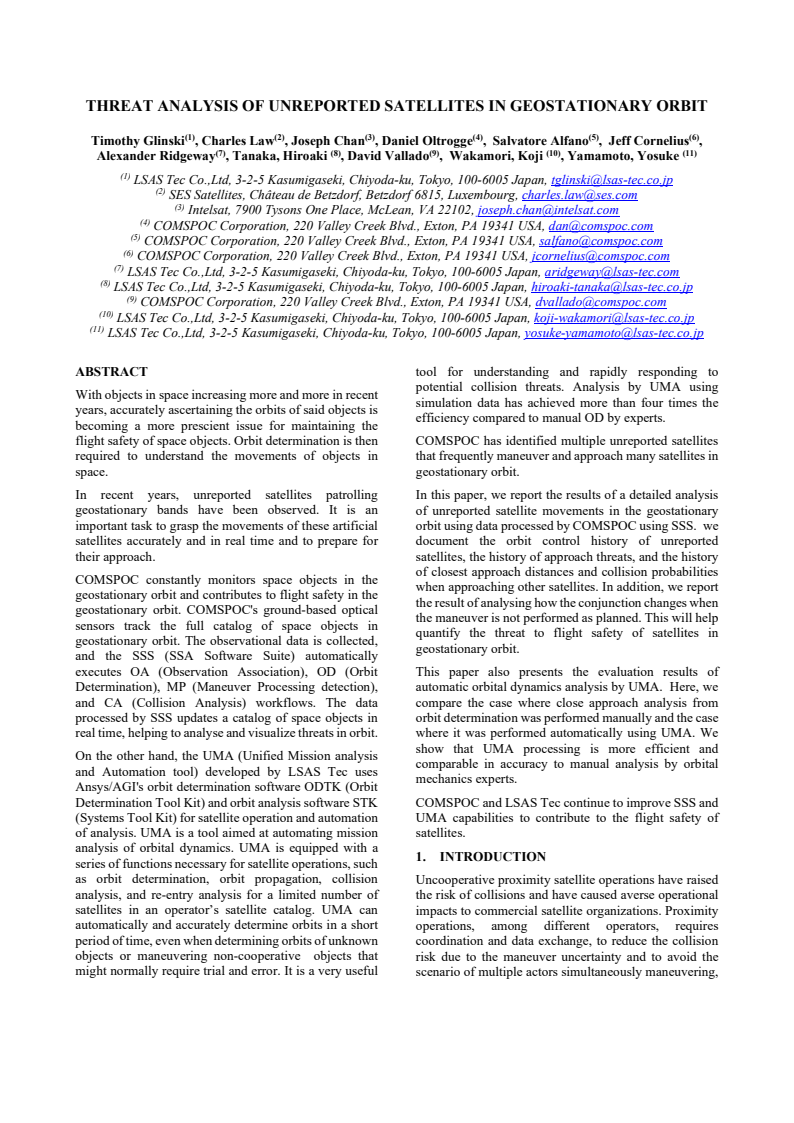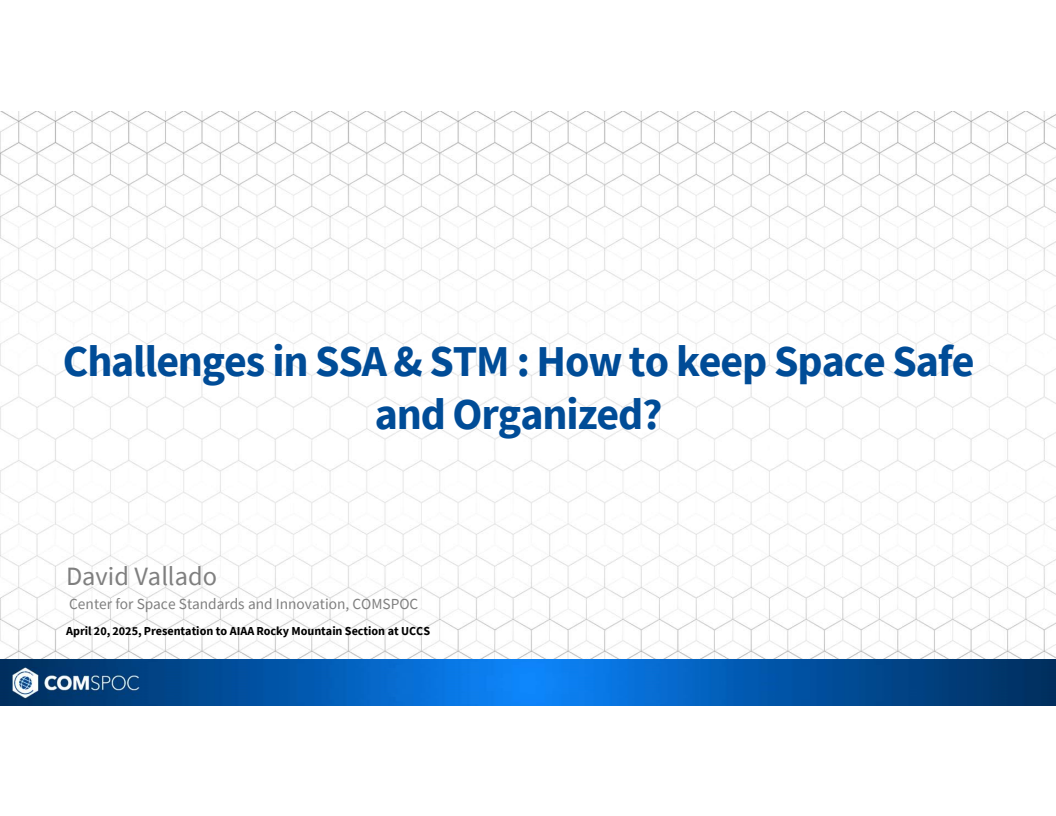Threat Analysis of Unreported Satellites in Geostationary Orbit


Id: 350
Type: Conference paper
Published: 05/24/2023
Event: IAASS Intl Spaced Safety Conference: "Making Space Travel Safer"
Authors:
Click an author to filter the list of related assets below.Abstract:
With objects in space increasing more and more in recent years, accurately ascertaining the orbits of said objects is becoming a more prescient issue for maintaining the flight safety of space objects. Orbit determination is then required to understand the movements of objects in space. In recent years, unreported satellites patrolling geostationary bands have been observed. It is an important task to grasp the movements of these artificial satellites accurately and in real time and to prepare for their approach. COMSPOC constantly monitors space objects in the geostationary orbit and contributes to flight safety in the geostationary orbit. COMSPOC's ground-based optical sensors track the full catalog of space objects in geostationary orbit. The observational data is collected, and the SSS (SSA Software Suite) automatically executes OA (Observation Association), OD (Orbit Determination), MP (Maneuver Processing detection), and CA (Collision Analysis) workflows. The data processed by SSS updates a catalog of space objects in real time, helping to analyse and visualize threats in orbit. On the other hand, the UMA (Unified Mission analysis and Automation tool) developed by LSAS Tec uses Ansys/AGI's orbit determination software ODTK (Orbit Determination Tool Kit) and orbit analysis software STK (Systems Tool Kit) for satellite operation and automation of analysis. UMA is a tool aimed at automating mission analysis of orbital dynamics. UMA is equipped with a series of functions necessary for satellite operations, such as orbit determination, orbit propagation, collision analysis, and re-entry analysis for a limited number of satellites in an operator’s satellite catalog. UMA can automatically and accurately determine orbits in a short period of time, even when determining orbits of unknown objects or maneuvering non-cooperative objects that might normally require trial and error. It is a very useful tool for understanding and rapidly responding to potential collision threats. Analysis by UMA using simulation data has achieved more than four times the efficiency compared to manual OD by experts. COMSPOC has identified multiple unreported satellites that frequently maneuver and approach many satellites in geostationary orbit. In this paper, we report the results of a detailed analysis of unreported satellite movements in the geostationary orbit using data processed by COMSPOC using SSS. we document the orbit control history of unreported satellites, the history of approach threats, and the history of closest approach distances and collision probabilities when approaching other satellites. In addition, we report the result of analysing how the conjunction changes when the maneuver is not performed as planned. This will help quantify the threat to flight safety of satellites in geostationary orbit. This paper also presents the evaluation results of automatic orbital dynamics analysis by UMA. Here, we compare the case where close approach analysis from orbit determination was performed manually and the case where it was performed automatically using UMA. We show that UMA processing is more efficient and comparable in accuracy to manual analysis by orbital mechanics experts. COMSPOC and LSAS Tec continue to improve SSS and UMA capabilities to contribute to the flight safety of satellites.
Keywords:
Click a keyword to filter the list of related assets below.Citation:
Glinski, T., Law, C., Chan, J., Oltrogge, D.L., Alfano, S., Cornelius, J., Ridgeway, A., Tanaka, H., Vallado, D., Wakamori, K., Yamamoto, Y., “Threat Analysis of Unreported Satellites in Geostationary Orbit,” 12th IAASS Conference, Osaka, Japan, 24 May 2023.
Papers with related authors:

Addressing the debilitating effects of maneuvers on SSA accuracy and timeliness
Read More
Deep operator and SSA collaboration for space sustainability
Read More
DEEP OPERATOR AND SSA COLLABORATION FOR SPACE SUSTAINABILITY
Read More
Using Spacebook and Cesium to Promote and Enhance Flight Safety
Read More
Actionability and Persistence Of Conjunction Data
Read More
Actionability and Persistence of Conjunction Data
Read More
Synthetic Covariance Production Using a New Digital Approach
Read More
Actionability and Persistence of Conjunction Data
Read More
Russian ASAT Debris Cloud Evolution and Risk
Read More
Results of comprehensive STCM data fusion experiment
Read More
Practical issues with using a full gravity field
Read More
Debris Risk Evolution And Dispersal (DREAD) for post-fragmentation modeling
Read More
Fragmentation event debris field evolution using 3d volumetric risk assessment
Read More
Application of New Debris Risk Evolution And Dissipation (DREAD) Tool to Characterize Post-Fragmentation Risk
Read More
Updated Analytical Partials for Covariance Transformations and Optimization
Read More






LEO satellite behavior during the May 2024 Gannon geomagnetic storm
Read More
Contrasting the Inflection Points and Efforts in Space Traffic Coordination and Management
Read More






Sequential Processing of ILRS Observations – Experiences over the last 5 years
Read More


Orbital Strategies to Mitigate the Solar Exclusion Effect on Space-Based Observation of the Geosynchronous Belt
Read More
New Consolidated Files for Earth Orientation Parameters and Space Weather Data
Read More
Sequential Orbit Determination Using Satellite Laser Ranging
Read More
Improved SSA through orbit determination of Two Line Element Sets
Read More


Evaluating Gooding Angles-only Orbit Determination of Space Based Space Surveillance Measurements
Read More
ORBIT DETERMINATION ISSUES AND RESULTS TO INCORPORATE OPTICAL MEASUREMENTS IN CONJUNCTION OPERATIONS
Read More


Papers with related keywords:

Space Traffic Coordination Framework for Success
Read More
2023 Updated Space Safety Coalition Best Practices for the Sustainability of Space Operations
Read More
Achieving Space Sustainability through Intense Operator and SSA Collaboration
Read More
Developing Space Standards to Foster International Collaboration
Read More
Space Situational Awareness from the Commercial Perspective: COMSPOC, SDA, and SSC
Read More